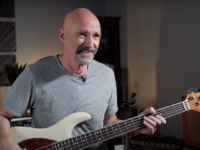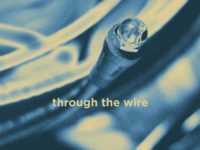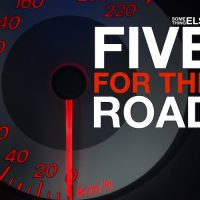Tony Levin, bassist with Peter Gabriel and King Crimson, joins us to discuss the unique slap-bass sound he created in Gabriel’s hit song “Big Time.” We also learn how an early-1980s gig alongside guitarist David Torn led to a fascinating trio project with drummer Alan White called Levin Torn White, issued by Lazy Bones Recordings. Elsewhere, we make connections from across his career back to White’s band Yes, and see how separate moments as a sideman with Paul Simon underscore the bassist’s celebrated changeability …
“BIG TIME,” with Peter Gabriel (SO, 1986): A No. 8 hit for Peter Gabriel, the song’s unique bouncing bass line provided the spark for a creative thought by Levin, who went on to develop “funk fingers,” a significant technological update to the old slap-bass sound. He’d later utilize this innovation on “One Slip” from Pink Floyd’s Momentary Lapse of Reason, King Crimson’s “People,” and Gabriel’s “Steam,” among many others.
TONY LEVIN: On “Big Time,” I had Jerry Marotta play on the bass with his drumsticks while I fingered the notes. Then, when touring a year later, I was trying to play that part with one drumstick in my hand (seen in the live clip above) and Peter himself suggested that I attach two drumsticks to my fingers. It took a while to get them right, but the end result was what I called “funk fingers.” For a time I sold them cheaply on my Web site, hoping bass players would start using them. They sold well, but I didn’t hear of anyone using them, so I discontinued selling them. In fact, I only have a few pairs for myself!
“THRAK (live),” with King Crimson (THRAKATTAK, 1996): Part of the legendary “double trio” period for King Crimson, as the proto-proggers returned after a 10-year absence following 1984’s 3 of a Perfect Pair. The concept presented unique challenges for those involved, with six members simultaneously contributing their own ideas.
TONY LEVIN: Challenging, for sure! It’s actually harder when you have someone else playing parts in your range — like, for the drummers when there are two, and in Crimson for me and Trey Gunn, both having bass instruments. As usual with Crimson, we embraced the challenge, trusted in Robert Fripp’s judgment that we had the right musicians, and that the direction would be new and worthwhile. The result did justify that trust. Ironically, I’m just heading out on a tour that will feature some of the Thrak music. Two trios are on the bill: Stick Men, featuring Crimson drummer Pat Mastelotto, touch guitarist Markus Reuter, and myself; and Adrian Belew’s Power Trio. We’ll each do a set, then combine for an extended set of Crimson music, including some of the ‘double trio’ music from the Thrak era.
“PREVIOUS MAN,” with David Torn (CLOUD ABOUT MERCURY, 1987): Levin’s initial project with Torn, with whom he’d also later work in the band Bruford Levin Upper Extremities. Also featured on Mercury was drummer Bill Bruford and trumpeter Mark Isham, perhaps best known as a composer of Hollywood scores. “The Previous Man” is one of a series of textured, improvisational songs that closes out the project, giving an early — if far less muscular — hint at the successes to come in Levin Torn White.
TONY LEVIN: I met David in the making of that album. Though we were neigbors in Woodstock, I hadn’t played with him before that. I felt that album was pretty ground breaking — if only for his bringing in a progressive-rock rhythm section to play on an ECM jazz album. We went in a good direction. Later, when I formed Bruford Levin Upper Extremities, both David and trumpet player Chris Botti just seemed like the right choice for that group, again mixing players from different backgrounds to form some new music ideas.
“BIRTHRIGHT,” with Anderson Bruford Wakeman Howe (ANDERSON BRUFORD WAKEMAN HOWE, 1989): This new record with Alan White isn’t the first time Levin has intersected with Yes, having already established a longtime working rapport with Bruford, the group’s original drummer. Levin made an appearance on Yes’ early 1990s effort Union after working as an uncredited member of the reunion project Anderson Bruford Wakeman Howe. At the time, the members of ABWH were unable to use the name Yes for legal reasons, but reportedly had Arista assign the catalog number of 90126 to this album — a subtle way, it’s said, of stamping this as the next Yes album after 90125. Bruford, later a member of King Crimson, recruited Crimson bandmate Levin to play bass in ABWH — a relationship that continued in Bruford Levin Upper Extremities, a group that also included Torn.
TONY LEVIN: It’s not possible to make a comparison between Bruford and White. In the situations with Bill, we rehearsed, wrote, and toured at length. With Alan, we fashioned this album mostly from Alan’s great improv playing, then my reacting to what he’d done, and then David reacting to both. A pretty radical approach to writing music, and it led to some very interesting music, I’d say.
“LATE IN THE EVENING,” with Paul Simon (ONE TRICK PONY, 1980): The challenge, and the joy, for this first-call sideman has been to remain adaptable. Sometimes, Levin’s work with a single artist can do much to illustrate that hard-won, often-uncanny flexibility. Take this Grammy-nominated Paul Simon track, which hit No. 6 in the U.S. in the wake of 1975’s charttopping “50 Ways to Leave Your Lover.” On both, you’ll find Levin’s stirringly versatile bass work. He’d played with a sparse openness on “50 Ways,” only to cut loose as this track undulated with a rhythmic gallop.
TONY LEVIN: Yes, challenge, yes joy — well put. I’ve been lucky, indeed, to play with some great people through the years, and those recordings with Paul were wonderful. I’d say, at this stage of my career, I’m aware of how much I love playing good music — and how lucky I am to be able to do it.
- How Deep Cuts on ‘Music From Big Pink’ Underscore the Band’s Triumph - July 31, 2023
- How ‘Islands’ Signaled the Sad End of the Band’s Five-Man Edition - March 15, 2022
- The Band’s ‘Christmas Must Be Tonight’ Remains an Unjustly Overlooked Holiday Classic - December 25, 2016




